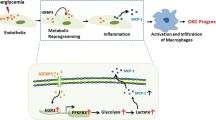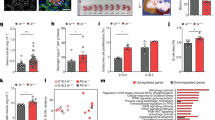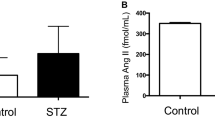Abstract
Aim:
Diabetic nephropathy is one of the major complications of diabetes and the major cause of end-stage renal disease. In this study we investigated the insulin deficiency (ID) induced changes in renal mesangial cells (MCs) and in the kidney of STZ-induced diabetic rats.
Methods:
Cultured rat renal MCs were incubated in ID media. Cell proliferation was analyzed using BrdU incorporation assay. The expression of insulin receptor (IR), insulin-like growth factor-1 receptor (IGF-1R), phosphorylated IGF-1R, fibronectin, and collagen IV was determined with Western blot analysis. STZ-induced diabetic rats were treated with an IGF-1R antagonist picropodophyllin (PPP, 20 mg·kg−1·d−1, po) for 8 weeks. After the rats were euthanized, plasma and kidneys were collected. IGF-1 levels in renal cortex were measured with RT-PCR or ELISA. The morphological changes in the kidneys were also examined.
Results:
Incubation in ID media significantly increased cell proliferation, the synthesis of fibronectin and collagen IV, and the expression of IGF-1 and IGF-1R and phosphorylated IGF-1R in renal MCs. Pretreatment of the cells with PPP (50 nmol/L) blocked ID-induced increases in cell proliferation and the synthesis of fibronectin and collagen IV; knockdown of IGF-1R showed a similar effect as PPP did. In contrast, treatment of the cells with IGF-1 (50 ng/mL) exacerbated ID-induced increases in cell proliferation. In the kidneys of diabetic rats, the expression of IGF-1, IGF-1R and phosphorylated IGF-1R were significantly elevated. Treatment of diabetic rats with PPP did not lower the blood glucose levels, but significantly suppressed the expression of TGF-β, fibronectin and collagen IV in the kidneys, the plasma levels of urinary nitrogen and creatinine, and the urinary protein excretion.
Conclusion:
Insulin deficiency increases the expression of IGF-1 and IGF-1R in renal MCs and the kidney of diabetic rats, which contributes to the development of diabetic nephropathy.
Similar content being viewed by others
Log in or create a free account to read this content
Gain free access to this article, as well as selected content from this journal and more on nature.com
or
References
Kolset SO, Reinholt FP, Jenssen T . Diabetic nephropathy and extracellular matrix. J Histochem Cytochem 2012; 60: 976–86.
Kanwar YS, Wada J, Sun L, Xie P, Wallner EI, Chen S, et al. Diabetic nephropathy: mechanisms of renal disease progression. Exp Biol Med (Maywood) 2008; 233: 4–11.
Brunskill EW, Potter SS . Changes in the gene expression programs of renal mesangial cells during diabetic nephropathy. BMC Nephrol 2012; 13: 70.
Shao D, Liu J, Ni J, Wang Z, Shen Y, Zhou L, et al. Suppression of XBP1S mediates high glucose-induced oxidative stress and extracellular matrix synthesis in renal mesangial cell and kidney of diabetic rats. PloS One 2013; 8: e56124.
Li JJ, Lee SH, Kim DK, Jin R, Jung DS, Kwak SJ, et al. Colchicine attenuates inflammatory cell infiltration and extracellular matrix accumulation in diabetic nephropathy. Am J Physiol Renal Physiol 2009; 297: F200–9.
Lupia E, Elliot SJ, Lenz O, Zheng F, Hattori M, Striker GE, et al. IGF-1 decreases collagen degradation in diabetic NOD mesangial cells: implications for diabetic nephropathy. Diabetes 1999; 48: 1638–44.
Wang Z, Ni J, Shao D, Liu J, Shen Y, Zhou L, et al. Elevated transcriptional co-activator p102 mediates angiotensin II type 1 receptor up-regulation and extracellular matrix overproduction in the high glucose-treated rat glomerular mesangial cells and isolated glomeruli. Eur J Pharmacol 2013; 702: 208–17.
Yuan P, Xue H, Zhou L, Qu L, Li C, Wang Z, et al. Rescue of mesangial cells from high glucose-induced over-proliferation and extracellular matrix secretion by hydrogen sulfide. Nephrol Dial Transplant 2011; 26: 2119–26.
Xue H, Yuan P, Ni J, Li C, Shao D, Liu J, et al. H2S inhibits hyperglycemia-induced intrarenal renin-angiotensin system activation via attenuation of reactive oxygen species generation. PLos One 2013; 8: e74366.
Shao D, Liu J, Ni J, Wang Z, Shen Y, Zhou L, et al. Suppression of XBP1S mediates high glucose-induced oxidative stress and extracellular matrix synthesis in renal mesangial cell and kidney of diabetic rats. PLos One 2013; 8: e56124.
Xue H, Zhou L, Yuan P, Wang Z, Ni J, Yao T, et al. Counteraction between angiotensin II and angiotensin-(1-7) via activating angiotensin type I and Mas receptor on rat renal mesangial cells. Regul Pept 2012; 177: 12–20.
Xue H, Yuan P, Zhou L, Yao T, Huang Y, Lu LM . Effect of adrenotensin on cell proliferation is mediated by angiotensin II in cultured rat mesangial cells. Acta Pharmacol Sin 2009; 30: 1132–7.
Gwaltney SN . Current approaches to the treatment of diabetes. Curr Top Med Chem 2008; 8: 1482.
Zeng R, Xiong Y, Zhu F, Ma Z, Liao W, He Y, et al. Fenofibrate attenuated glucose-induced mesangial cells proliferation and extracellular matrix synthesis via PI3K/AKT and ERK1/2. PLos One 2013; 8: e76836.
Peti-Peterdi J . High glucose and renin release: the role of succinate and GPR91. Kidney Int 2010; 78: 1214–7.
Arora MK, Singh UK . Oxidative stress: meeting multiple targets in pathogenesis of diabetic nephropathy. Curr Drug Targets 2014; 15: 531–8.
Balakumar P, Arora MK, Reddy J, Anand-Srivastava MB . Patho-physiology of diabetic nephropathy: involvement of multifaceted signalling mechanism. J Cardiovasc Pharmacol 2009; 54: 129–38.
Fukami K, Yamagishi S, Coughlan MT, Harcourt BE, Kantharidis P, Thallas-Bonke V, et al. Ramipril inhibits AGE-RAGE-induced matrix metalloproteinase-2 activation in experimental diabetic nephropathy. Diabetol Metab Syndr 2014; 6: 86.
Hu J, Klein JD, Du J, Wang XH . Cardiac muscle protein catabolism in diabetes mellitus: activation of the ubiquitin-proteasome system by insulin deficiency. Endocrinology 2008; 149: 5384–90.
Wang Y, Deb DK, Zhang Z, Sun T, Liu W, Yoon D, et al. Vitamin D receptor signaling in podocytes protects against diabetic nephropathy. J Am Soc Nephrol 2012; 23: 1977–86.
Haider S, Ahmed S, Tabassum S, Memon Z, Ikram M, Haleem DJ . Streptozotocin-induced insulin deficiency leads to development of behavioral deficits in rats. Acta Neurol Belg 2013; 113: 35–41.
Ye R, Holland WL, Gordillo R, Wang M, Wang QA, Shao M, et al. Adiponectin is essential for lipid homeostasis and survival under insulin deficiency and promotes beta-cell regeneration. Elife 2014; 3. doi: 10.7554/eLife.03851.
Ley EJ, Srour MK, Clond MA, Barnajian M, Tillou A, Mirocha J, et al. Diabetic patients with traumatic brain injury: insulin deficiency is associated with increased mortality. J Trauma 2011; 70: 1141–4.
Bayat AH, Haghparast A . Effect of insulin deficiency on the rewarding properties of methamphetamine in streptozotocin-induced diabetic rats. Pharmacol Biochem Behav 2015; 128: 8–13.
Ullrich A, Bell JR, Chen EY, Herrera R, Petruzzelli LM, Dull TJ, et al. Human insulin receptor and its relationship to the tyrosine kinase family of oncogenes. Nature 1985; 313: 756–61.
Singh P, Alex JM, Bast F . Insulin receptor (IR) and insulin-like growth factor receptor 1 (IGF-1R) signaling systems: novel treatment strategies for cancer. Med Oncol 2014; 31: 805.
Weroha SJ, Haluska P . The insulin-like growth factor system in cancer. Endocrinol Metab Clin North Am 2012; 41: 335–50.
Kawai M, Rosen CJ . The insulin-like growth factor system in bone: basic and clinical implications. Endocrinol Metab Clin North Am 2012; 41: 323–33.
Rabkin R, Schaefer F . New concepts: growth hormone, insulin-like growth factor-I and the kidney. Growth Horm IGF Res 2004; 14: 270–6.
Chu CH, Tzang BS, Chen LM, Kuo CH, Cheng YC, Chen LY, et al. IGF-II/mannose-6-phosphate receptor signaling induced cell hypertrophy and atrial natriuretic peptide/BNP expression via Galphaq interaction and protein kinase C-alpha/CaMKII activation in H9c2 cardiomyoblast cells. J Endocrinol 2008; 197: 381–90.
Haisa M . The type 1 insulin-like growth factor receptor signalling system and targeted tyrosine kinase inhibition in cancer. J Int Med Res 2013; 41: 253–64.
Estrada JA, Contreras I, Pliego-Rivero FB, Otero GA . Molecular mechanisms of cognitive impairment in iron deficiency: alterations in brain-derived neurotrophic factor and insulin-like growth factor expression and function in the central nervous system. Nutr Neurosci 2014; 17: 193–206.
Dupraz S, Grassi D, Karnas D, Nieto GA, Hicks D, Quiroga S . The insulin-like growth factor 1 receptor is essential for axonal regeneration in adult central nervous system neurons. PLos One 2013; 8: e54462.
Szkudelski T . The mechanism of alloxan and streptozotocin action in B cells of the rat pancreas. Physiol Res 2001; 50: 537–46.
ter Wee PM, Donker JM . Diabetic nephropathy in insulin-dependent diabetic patients: renal hemodynamics and derived treatment strategies. J Diabet Complications 1989; 3: 62–9.
Acknowledgements
This research was financially supported by the National Natural Science Foundation of China (No 81470591, 81170636) to Li-min LU, and (No 81100531) to Wei ZHANG.
Author information
Authors and Affiliations
Corresponding authors
Rights and permissions
About this article
Cite this article
Kong, Yl., Shen, Y., Ni, J. et al. Insulin deficiency induces rat renal mesangial cell dysfunction via activation of IGF-1/IGF-1R pathway. Acta Pharmacol Sin 37, 217–227 (2016). https://doi.org/10.1038/aps.2015.128
Received:
Accepted:
Published:
Issue date:
DOI: https://doi.org/10.1038/aps.2015.128
Keywords
This article is cited by
-
Uncovering the mechanism of resveratrol in the treatment of diabetic kidney disease based on network pharmacology, molecular docking, and experimental validation
Journal of Translational Medicine (2023)
-
Inflammation-activated CXCL16 pathway contributes to tubulointerstitial injury in mouse diabetic nephropathy
Acta Pharmacologica Sinica (2018)
-
SND p102 promotes extracellular matrix accumulation and cell proliferation in rat glomerular mesangial cells via the AT1R/ERK/Smad3 pathway
Acta Pharmacologica Sinica (2018)



